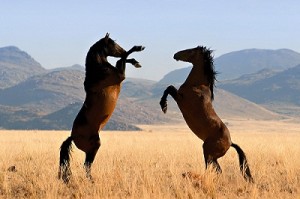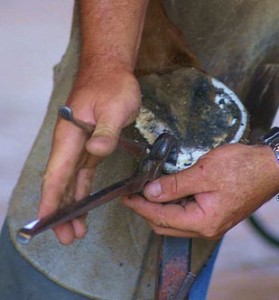 A horse’s hoof is an amazing piece of workmanship. It serves as a pump and shock observer. For it to work properly, it should be able to flex, contract and expand. The entire hoof supports the horse, thus when able to work properly, the hoof can minimize soreness, fatigue, lameness as well as other issues.
A horse’s hoof is an amazing piece of workmanship. It serves as a pump and shock observer. For it to work properly, it should be able to flex, contract and expand. The entire hoof supports the horse, thus when able to work properly, the hoof can minimize soreness, fatigue, lameness as well as other issues.
Horses left in the wild do not possess laminitis or navicular disease. These horses have heels that are not contracted as well as do not have quarter cracks. They have amazingly sturdy soles and frogs as well as thick hoof walls. They are tough and can easily travel on rough terrains. By providing domestic horses with diet restrictions and natural hoof care, we can help them grow hooves similar to wild horses.
Natural trimming is a balanced trim that enables your horse to acquire the optimal hoof. Regular trims (every 4 to 6 weeks) and respect for the healing angle is vital. To improve circulation, hooves should be allowed to contract and expand naturally. In addition, diet and adequate exercise can help in the process. This is applicable to all breeds.
When removing the shoes, understand that the hoof will be in contact with the ground for the first time in a long time. Gradually, circulation will return to the hoof and the horse will be feeling the ground again. For some horses, they may need some boots during the transition. Providing boots will provide comfort and mobility to your horse. Use only certified trimmers for the task. Although, there are many barefoot trimmers available, there are some that can actually do more harm than good.
Barefoot Trimming
 The initial process of the trim usually requires the use of hoof nippers. Currently, there are various styles of barefoot trims used; they include the Natural trim, the Four-point trim, the Pete Ramey trim, and the Strasser Trim.
The initial process of the trim usually requires the use of hoof nippers. Currently, there are various styles of barefoot trims used; they include the Natural trim, the Four-point trim, the Pete Ramey trim, and the Strasser Trim.
There are some barefoot trim types that can be used alone or with shoes such that of the 4 Point Trim. Barefoot trimming is different compared to the usual services of farriers. It takes into consideration hoof health and bony column angles.
Compared to trims usually provided by farriers (pasture trim), barefoot trimming is introduced as a natural hoof care approach or as a method that can provide high performance hooves without the need of shoes. The aim is to allow domestic horses to grow hooves that are designed by nature such as having hooves that are healthy, sturdy and without shoes or hooves that are similar to those of wild horses such as the American Mustang, Australian Brumby, wild zebras and other wild horse breeds. Some research suggests that using barefoot trimming methods can reduce or even eliminate laminitis and navicular syndrome.
Wild horses tend to have hooves that make contact with the ground on 4 points, without having the hoof wall to touch the ground. This is one of the differences between the pasture trim and barefoot trim as pasture trim requires the wall to be left longer and in contact with the ground.
Barefoot trimming guidelines usually require the hoof wall to be on the ground as the most distal structure. The frogs, sole and bars provide support when horse is on rough terrains. Just like wild horses, barefoot domestic horses can grow callouses on their hooves’ soles, enabling them to move over any type of terrain without feeling any discomfort.
In order to achieve a successful barefoot trimming, there are factors that need to be considered such as the domestic horse’s environment and function and their effects on the horse’s hoof shape, balance as well as comfort of the horse. Here are the objectives depending on the type of method used:
1. For best hoof conformation, the hoof wall and heel need to be shortened to the outer edge of the concave wall.
2. To promote the right break-over and to prevent flaring and chipping of the wall, a rounded bevel or mustang roll should be applied to the bottom edge of the wall.
An important part in the barefoot trim process is efficiently managing the horse’s diet and boarding conditions. If the wrong diet is applied then the horse will feel uneasy as well as will be exposed to risks of inflammation.
Feeding your horse with the right grass hay is essential. Generally, grass that is less mature has less sugar content. A lot of horses acquire mild chronic laminitis due to fructan (sugar) found in lush grass hay. Minimizing the alfalfa in the horse diet can improve your horse’s health as well as the hoof quality.
Another important dietary management is the elimination of sweetened feeds. While molasses possess nutrition, it can cause health problems such as Cushings Disease and Equine Diabetes, which can lead to laminitis.
If you want your horse to be successful barefooted, you need to help it maintain the proper weight. Having your horse barefoot does not always mean a healthier horse than a shod horse. A fat, neglected and poorly trimmed barefoot horse will not be as strong and healthy compared to a well cared for shod horse.

